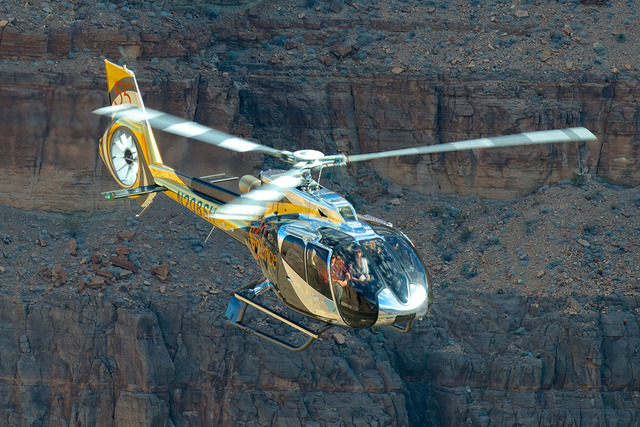Vegas air tour operators take Obama visit disruption in stride

For more than 100 people who spent big bucks and traveled thousands of miles to get to Southern Nevada last week, President Obama’s three-day trip to Las Vegas resulted in a huge disappointment.
They had to postpone or cancel their helicopter trips to see the Grand Canyon.
But, as disappointing as it was to them, the closure of airspace and city streets could have been worse for tourists as well as residents of the city. Some tourism advocates say the coordination between federal agencies and local officials was better than expected.
It also helped that the disruption occurred in November, off the peak tourism season.
“Our business was altered quite a bit and it easily could have gone the other way,” said Bryan Kroten, vice president of marketing for Maverick Helicopters, which flies the Grand Canyon from its base on the west side of McCarran International Airport.
“It went fairly well for us, all things considered,” added Kroten’s McCarran neighbor, Bob Engelbrecht, CEO of Sundance Helicopters. “But it was an interruption to our business and you don’t like to see that.”
Obama arrived at McCarran around noon Friday, well after the morning commute, and departed Sunday morning.
For motorists, the arrival was the biggest inconvenience of the trip. The Las Vegas Metropolitan Police Department, working in support of the Secret Service, didn’t disclose in advance the size of the presidential motorcade or the route he was taking from McCarran to Del Sol High School. That was where Obama signed what many consider to be a historic executive order reforming immigration policy.
Hundreds of motorists on streets around McCarran were jammed in traffic resulting from rolling street closures as the motorcade made its way to Del Sol. Russell and Sunset roads were closed, as was the McCarran access tunnel for a short period.
After the appearance at the school, Obama was escorted to Lake Las Vegas where he overnighted Friday and Saturday — playing golf Saturday and Sunday — before returning to the airport Sunday morning when ground traffic disruption was less of an issue. Some motorists complained that the presidential entourage made them late for church, however.
But a bigger disruption occurred in the air.
For the Grand Canyon air tours, the return route from the canyon is over the top of Lake Las Vegas, airspace that was closed to helicopters for a 30-mile radius.
Engelbrecht said the airspace closure and the arrival and departure of Air Force One created the biggest headache for his company.
“We worked primarily with the TSA (Transportation Security Administration) and the FAA (Federal Aviation Administration) tower,” Engelbrecht said. “Because we operate out of McCarran, we were probably the most impacted carrier.”
Engelbrecht said his company lost five flights — two on Friday, one on Saturday and two on Sunday — as a result of Obama’s visit.
For helicopter air tours, a “flight” isn’t just one aircraft taking off; it’s a wave of them. Sundance usually has six to eight helicopters per flight.
Each helicopter normally carries six passengers. But because the helicopters had to go around the 30-mile zone, they had to carry more fuel and one less passenger each.
Air tour operators normally book reservations several weeks out and Engelbrecht got official word of the Obama visit two days ahead of his arrival. That put Sundance in a scramble to reschedule or, in some cases, cancel the reservations of passengers.
While the president was in Southern Nevada, helicopter passengers had to undergo a security screening not otherwise required for tour flights. That forced passengers to arrive at the terminal earlier than normal.
Engelbrecht said he didn’t have an exact count of how many customers canceled flights compared with how many postponed them.
In past VIP visits, air tour operators had enough lead time to mitigate some of the financial damage. Papillon, another helicopter tour company, operates most of its flights from Boulder City Airport. Maverick and Sundance have temporarily moved their departures to Henderson, Boulder City or Jean. That’s what happened in 2012, when Obama last made an extended visit to Southern Nevada. On that trip he also stayed at Lake Las Vegas while preparing for a presidential debate with Mitt Romney.
A vocal critic of presidential visits was Nigel Turner, who estimated that his Heli-USA lost $60,000 per day as a result of the Obama visit. The company has since gone bankrupt.
“We definitely had reduced capacity, but our workers kept working and our helicopters were in the air,” Kroten said of last week’s visit. “We were able to keep our Las Vegas night flights operating and I’d say the federal government went out of their way to help us.”
“It’s a fact of life that when you work in Las Vegas that you’re going to have some disruptions when you have the president, the vice president or other VIPs visiting,” Engelbrecht said. “We got some help from our helicopter association in Washington to help minimize some of the problems, but this is something that’s going to happen occasionally here and in Hawaii.”
Follow @RickVelotta on Twitter.Contact reporter Richard N. Velotta at rvelotta@reviewjournal.com or 702-477-3893.